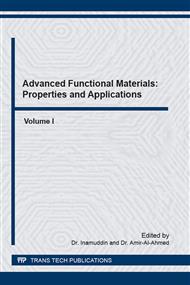[1]
R.C. Agrawal, R.K. Gupta, Studies on ionic transport properties of a new Ag+ ion conducting composite electrolyte system (1−x)[0·75 AgI: 0·25 AgCl]: xSnO2, Bull. Mater. Sci. 19 (1996) 573-579.
DOI: 10.1007/bf02744830
Google Scholar
[2]
N.F. Uvarov, Composite solid electrolytes: recent advances and design strategies, J. Solid State Electrochem. 15 (2011) 367-389.
DOI: 10.1007/s10008-008-0739-4
Google Scholar
[3]
Z. Li, Impedance analysis and protonic conduction mechanism in RbH2PO4/SiO2 composite systems, Electrochim. Acta 55 (2010) 7298-7304.
DOI: 10.1016/j.electacta.2010.07.006
Google Scholar
[4]
J. Maier, Defect chemistry in heterogeneous systems, Solid State Ionics 75 (1995) 139-145.
DOI: 10.1016/0167-2738(94)00222-e
Google Scholar
[5]
L. Fan, Y. Ma, X. Wang, M. Singh, B. Zhu, Understanding the electrochemical mechanism of the core–shell ceria–LiZnO nanocomposite in a low temperature solid oxide fuel cell, J. Mater. Chem. A. 2 (2014) 5399-5407.
DOI: 10.1039/c3ta14098a
Google Scholar
[6]
H. Yamada, I. Moriguchi, T. Kudo, Nano-structured Li-ionic conductive composite solid electrolyte synthesized by using mesoporous SiO2, Solid State Ionics 176 (2005) 945-953.
DOI: 10.1016/j.ssi.2004.11.013
Google Scholar
[7]
V.G. Ponomareva, G.V. Lavrova, Influence of dispersed TiO2 on protonic conductivity of CsHSO4, Solid State Ionics106 (1998) 137-141.
DOI: 10.1016/s0167-2738(97)00482-7
Google Scholar
[8]
N.F. Uvarov, B.B. Bokhonov, V.P. Isupov, E.F. Hairetdinov, Nanocomposite ionic conductors in the Li2SO4. Al2O3 system, Solid State Ionics 74 (1994) 15-27.
DOI: 10.1016/0167-2738(94)90432-4
Google Scholar
[9]
K. Miyazaki, Y. Kato, T. Matsui, S. Hayashi, Y. Iriyama, T. Fukutsuka, T. Abe, Z. Ogumi, Formation of fuzzy, phases with high proton conductivities in the composites of polyphosphoric acid and metal oxide nanoparticles, Phys. Chem. Chem. Phys. 14 (2012).
DOI: 10.1039/c2cp41612c
Google Scholar
[10]
N.F. Uvarov , P. Vanek , M. Savinov , V. Zelezny , V. Studnicka , J. Petzelt, Percolation effect, thermodynamic properties of AgI and interface phases in AgI–Al2O3 composites, Solid State Ionics 127 (2000) 253-267.
DOI: 10.1016/s0167-2738(99)00288-x
Google Scholar
[11]
F. Fujishiro, S. Mochizuki, The interfacial effect on ionic conduction of AgI–anatase TiO2 composites, Solid State Ionics 180 (2009) 497-500.
DOI: 10.1016/j.ssi.2008.12.012
Google Scholar
[12]
K. Singh, J. Randhawa, P. Khadakkar, S.S. Bhoga, Synthesis and characterization of Ag2SO4–ABO3 (A=Li/Ba and B=Nb/Ti) heterogeneous solid electrolyte systems, Solid State Ionics 126 (1999) 47-53.
DOI: 10.1016/s0167-2738(99)00120-4
Google Scholar
[13]
D.P. Singh, K. Shahi, K.K. Kar, Scaling behavior and nearly constant loss effect in AgI–LiPO3 composite glasses, Solid State Ionics 231 (2013) 102-108.
DOI: 10.1016/j.ssi.2012.10.025
Google Scholar
[14]
K. Singh, S.M. Pande, S.W. Anwane, S.S. Bhoga, A study of iso- and alio-valent cation doped Ag2SO4 solid electrolyte, Appl. Phys. A. 66 (1998) 205-215.
DOI: 10.1007/s003390050657
Google Scholar
[15]
N.F. Uvarov, M.C.R. Shastry, K.J. Rao, Structure and ionic transport in Al2O3 containing composites, Rev. Solid State Sci. 4 (1990) 61-67.
Google Scholar
[16]
N.F. Uvaro, E.F. Hairetdinov, I.V. Skobelev, Composite solid electrolytes MeNO3-Al2O3 (Me = Li, Na, K), Solid State Ionics 86-88 (1996) 577-580.
DOI: 10.1016/0167-2738(96)00208-1
Google Scholar
[17]
M.C.R. Shastry, K.J. Rao, Structure and electrochemistry of LixMnyNi1−yO2, Solid State Ionics 51 (1992) 311-318.
Google Scholar
[18]
S.A. Suthanthiraraj, R. Sarumathi, Electrical and Structural study of New Antimony Iodide doped Silver Sulphate Electrolyte, Ionics 19(8) (2013) 1145-1153.
DOI: 10.1007/s11581-012-0826-5
Google Scholar
[19]
M.S. Nawaz, Rafiuddin, Ionic conduction and effect of cation doping in Tl4HgI6, Ionics 13 (2007) 35-40.
DOI: 10.1007/s11581-007-0069-z
Google Scholar
[20]
B. Tareev, Physics of Dielectric Materials, MIR Publications, Moscow (1979).
Google Scholar
[21]
S.G. Ting-Kuo Fey, R.F. Shiu, V Subramanian, C.L. Chen, The effect of varying the acid to metal ion ratio R on the structural, thermal, and electrochemical properties of sol–gel derived lithium nickel cobalt oxides, Solid State Ionics 152 (2002).
DOI: 10.1016/s0167-2738(02)00065-6
Google Scholar
[22]
S.A. Ansari, A. Nisar, B. Fatma, W. Khan, A.H. Naqvi, Investigation on structural, optical and dielectric properties of Co doped ZnO nanoparticles synthesized by gel-combustion route, Mater. Sci. Eng. B. 177 (2012) 428-435.
DOI: 10.1016/j.mseb.2012.01.022
Google Scholar
[23]
I.H. Gul, A.Z. Abbasi, F. Amin, M. Anis-ur-Rehman, A. Maqsood, Structural, magnetic and electrical properties of Co1−xZnxFe2O4 synthesized by co-precipitation method, J. Magn. Magn. Mater. 311 (2007) 494-499.
DOI: 10.1016/j.jmmm.2006.08.005
Google Scholar
[24]
K.M. Batoo, S. Kumar, C.G. Lee, Alimuddin, Study of dielectric and ac impedance properties of Ti doped Mn ferrites, Curr. Appl. Phys. 9 (2009)1397-1406.
DOI: 10.1016/j.cap.2009.03.012
Google Scholar
[25]
M.N. Ahamad, K.B.R. Varma, Dielectric properties of (100−x)Li2B4O7–x(Ba5Li2Ti2Nb8O30) glasses and glass nanocrystal composites, Mater. Sci. Eng. B. 167 (2010) 193-201.
DOI: 10.1016/j.mseb.2010.02.016
Google Scholar
[26]
A. Viswanathan, S.A. Suthanthiraraj, Impedance and modulus spectroscopic studies on the fast ion conducting system CuI. Ag2MoO4, Solid State Ionics 62 ( 1993 ) 79-83.
DOI: 10.1016/0167-2738(93)90254-z
Google Scholar
[27]
M.C.R. Shastry, K.J. Rao, ac conductivity and dielectric relaxation studies in AgI-based fast ion conducting glasses, Solid State lonics 44 ( 1991 ) 187-198.
DOI: 10.1016/0167-2738(91)90007-x
Google Scholar
[28]
S. Selvasekarapandian, R.C. Devi, Dielectric studies on a solid electrolyte AgI-PbBr2-Ag2O-B2O3, Mater. Chem. Phys. 58 (1999) 90-93.
DOI: 10.1016/s0254-0584(98)00256-9
Google Scholar


